Google Ads works best when your ad matches exactly what a person is looking for.
That sounds simple, but it’s not always easy to accomplish as an advertiser.
There are tons of different search query combinations for the keywords you pick and about 15% of search queries are completely new, even to Google.
So to run successful Search Ads campaigns, you need to cover a wide range of keywords and, ideally, have a unique ad for each of them.
Doing that effectively requires balancing the granularity of campaigns with the time it takes to create them.
Single Keyword Ad Groups (also called SKAGs) offer an answer to this challenge.
But Google Ads isn’t the same as when that strategy first came out. So in this article, we’ll take a look at what SKAGS are, if they are still relevant and what other options you have.
Table of Contents
What Are Single Keyword Ad Groups?
If we look at all the different ways you can structure a Google Ads campaign, it looks a little like this:
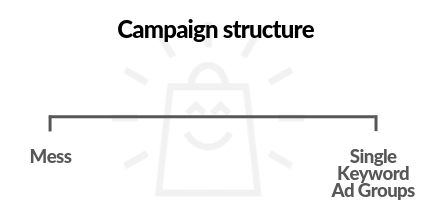
The two extremes are:
- Extreme 1: Mess – 1 ad group with all your keywords
- Extreme 2: Single keyword ad groups – one keyword per ad group
At one end you have a campaign with a single ad group with hundreds of keywords in it.
A simple example illustrates the problems with this approach:
If you sell books and you add every keyword that’s related to your products in only one ad group, you have the same advertisement showing for both “erotic novels” and “kids books”.
Your ads will fail to match what searchers are looking for, which will show itself in a low CTR and low conversion rates.
At the other extreme, there are the Single Keyword Ad Groups (or SKAGs) is simple: each ad group contains one keyword and has its own customized ads. That means that you’re able to create an advertisement that 100% matches what someone is searching for.
For a long time, it was a very good approach to tackle almost any type of campaign. But in the last couple of years, the SKAG strategy has become a lot less effective.
Before diving into the details of what has changed and how to adapt your approach, I want to show you an example.
🚨 The Danger Of Getting Too Granular (Case Study)
The main danger with the Single Keyword Ad Group approach is that you get too granular and lose control as a result of it.
To show you what too granular looks like, we’re going to look at the Google Ads campaigns of Rent The Runway.
Rent The Runway rents out designer clothing. They are a big company and target keywords with massive search volumes.
Below is a list of different search terms, the associated keywords and the campaign that serves the ad:
Search query #1: clothing subscription
Keyword: [subscription clothing]
Campaign name: Google – Nonbrand – Subscription-Boxes – Exact
Search query #2: clothing membership
Keyword: best clothing subscription service
Campaign name: Google – Nonbrand – Subscription-Boxes – Broad
From these two examples, it appears that Rent The Runway has dedicated campaigns for exact match and broad match keywords. This is a common strategy these days.
Let’s take a look at another set of keywords:
Search query #3: rental dress
Keyword: [rent a dress]
Campaign name : Google – Nonbrand – Rental – Dress – Exact
Search query #4: dress rental
Keyword: [dress rental]
Campaign name: Google – Nonbrand – Rental – Dresses – Exact – tCPA
These last two examples show the problem that we’re facing with Single Keyword Ad Groups.
It appears that Rent The Runway has different campaigns for exact match keywords for both “Dress” and “Dresses”.
In the first example, that is correct, the search query is for “rental dress” and it is matched with the “Dress” campaign (singular).
But the second example, also for a singular search query, “dress rental” gets served from the plural campaign.
The problem I’m trying to illustrate here is that they’ve taken the time to create two different campaigns for singular or plural search queries, but it’s not working as they intended.
Because both campaigns can show up, it becomes hard to set different bids or assign a different budget to these campaigns.
And this is a company with a huge ad budget, so if they’re suffering from this, you’ll face the same problem.
Don’t worry if it isn’t 100% clear yet, we’ve got plenty of ground to cover 🤓
The Benefits of Single Keyword Ad Groups
In this section we’ll take a look at the biggest reason why Single Keyword Ad groups have become so popular these last couple of years:
- Supercharge your clickthrough rate
- More control over your bids
- Easy to learn and teach
1. Supercharge Your CTR
When adopting SKAGs, your clickthrough rate can go up significantly.
The first reason for that is simple: you mention the search query in your ad.
This will make your ad seem a lot more relevant compared to ad groups that have a lot of different keywords in them.
In the screenshot below, you can see the search results for “sunglasses for men”.
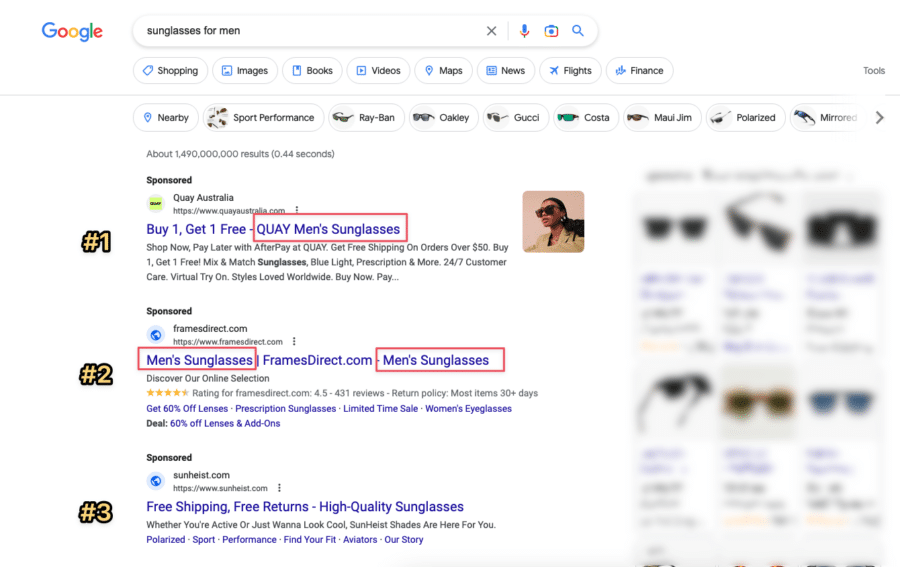
Of these 3 ads, only advertisers #1 & #2 leverage the keyword in the Headline. The FramesDirect ad even has 2 identical headlines. (Not ideal!)
Ad #3 doesn’t mention anything about men. This will hurt their CTR which impacts the quality score and requires them to pay more for these search queries.
2. More Control Over Your Bids
Because you’ve broken out every important keyword and match type in your campaign, you’re able to set a specific bid for them.
You could, for example, see that a phrase match keyword is outperforming its exact match counterpart. This setup allows you to adjust your bid accordingly.
In some industries, like supplements, CPCs can go into the $5-10 range. Then you need all the control you can to make sure your budget is spent effectively.
3. Easy to Learn and Teach
When it comes to optimizing Search Ads campaigns, what to do next is depends on the data that’s coming in, which is different in every situation.
The SKAGs approach is a lot easier. You can follow a simple rule on when to add a new keyword or when to create a new ad group.
That makes it easy to teach, especially in an agency environment where you want most of your Google Ads experts to follow a standardized approach.
That’s why I think this played a significant factor contributing to the popularity of the SKAG strategy.
The Downsides of Single Keyword Ad Groups
But it’s not all sunshine and rainbows. The SKAG strategy has a couple of obvious downsides:
- Creating single keyword ad groups is time-consuming
- Hard to keep an overview
- Slower ad testing
- Low search volume warnings cripple your campaign
1. Creating Single Keyword Ad Groups is Time-Consuming
Setting up your Google Ads campaign with a SKAG approach takes plenty of time, especially if you have hundreds (or even thousands) of keywords in your Google Ads account.
First, you’ll need to duplicate and tweak all the different ad groups and keywords.
What is more difficult is creating specific ads. Ideally, you create 2 ads to test in each ad group and for more popular keywords 3.
That can be a slow process, although there are ways to move faster, especially when starting out.
2. Hard to Keep An Overview
Similar to the problem in the previous section, if the number of ad groups increases, it can be hard to keep an overview of your SKAG campaign.
Also, if you have hundreds of ad groups, each has its own ad and search terms report to keep track off. (And act on).
This is not insurmountable, but these accounts look scary when you open them. This can be a big downside for beginners.
3. Ad Testing takes longer
The more ad groups you have, the more your traffic volume will be spread amongst them.
So if you’re testing 2 ads to see which one performs better, your experiment will take longer to reach a conclusion:
One ad group with ten keywords that gets 1000 clicks a month will show results a lot quicker compared to a campaign that has the same 10 keywords in 10 different ad group.
With Responsive Search Ads, you could try to can test assets across campaigns, but it’s a lot harder to do this well.
4. Low search volume warnings cripple your campaign
This isn’t so much a downside as it is an incorrect application of the approach.
If you’re a bit too enthusiastic with creating new ad groups, you might end up with keywords that show the status: “Low search volume”.

This is status seems harmless, but here is what Google says about it:
Keywords marked as “Low search volume” are associated with very little search traffic on Google (…) For this reason, Google temporarily makes these keywords inactive so that they don’t trigger your ads.
This effectively means that you won’t show ads for that specific keyword, which results in a lot of wasted effort.
The way around this is to not get too granular. Only split off keywords into their own ad groups if they get at least 20-30 searches per month.
Are Single Keyword Ad Groups Still Relevant in 2025?
The downsides I mentioned above have always existed, but the SKAG strategy has taken off nevertheless.
But in the last couple of years, Google has made many changes that have had a serious impact on single keyword ad groups.
The extent to which these changes have made this strategy useless is a hot topic in the Per Per Click community.
The core of SKAGS (focus on increasing the CTR) still make sense, but the approach needs to be adapted to the current landscape.
So in this section, we’ll dig into what has changed and how to adapt the SKAG strategy to use this approach efficiently in Google Ads.
Evolving Keyword Match Types
Keyword match types are the core foundation of Google Search Ads.
They might seem straightforward, but over the last few years, there have been many changes to what these match types actually do.
Let me get you up to speed with a small overview.
2014: Google introduces close variants
These close variants are search terms that are similar, but not identical to your keywords.
Examples for close variants include misspellings, singular or plural forms, stemming, abbreviations, and accents.
A search for “garden hose” would also trigger ads for “garden hoses”. This meant that creating specific ad groups for singular and plural keywords was useless.
2017: Expanding exact match
The close variants update already broadened the meaning of exact match meaning, but Google didn’t stop there.
Next, they added reordered words and the addition or removal of function words.
That meant that [light blue jeans for men] and [mens jeans light blue] would trigger the same search terms (and essentially are the same keywords).
2018: Synonyms and intent come to exact match
At the end of 2018, Google expanded the exact match type even further.
From then on, exact match keywords could also trigger ads for synonyms and paraphrases AND searches with the same search intent.
Two examples of that:
- robot lawn mower cost = robot lawn mower price
- garden hoses = water hoses
2019: Synonyms and intent come to phrase and modified broad match
Next the synonyms and intent updates rolled out to modified broad and phrase match as well.
2020: The rebirth of broad match
Using broad match in a campaign used to be a mortal sin. A clear sign that someone didn’t know what they were doing.
But in 2020, something flipped and Google’s keyword matching got to a point where broad match started brining in great results.
2021: Google kills modified broad match
Modified broad match used to be my go-to match type for new campaigns.
It offered the right mix of bringing in new searches, while also not going too wide like broad match did.
But Google killed this match type, and phrase match took over all functionality.
2023: Exact match keeps expanding
This is a change that has never actually been announced by Google, but it’s something that I’ve definitely noticed.
Today, the exact match will use the same word order and length of the keyword but will show a lot of synonyms and closely related terms. This can be quite frustrating if you’re trying to limit searches to a few very specific terms!
It’s clear that there have been MANY changes over the last few years.
These changes have increased the number of impressions and clicks for most advertisers, which has resulted in more money for Google.
For retailers using the platform, it has become more difficult to control for which searches your ads will show up.
The Consequences For SKAGs
All of these changes have made it more difficult to get a single keyword ad groups right. Here are the problems I’ve seen in my own campaigns.
Messy Campaigns
The promise of single keyword ad groups was clarity over which ad is matched with which search query.
The changes discussed above have made things a lot messier.
Having multiple ad groups that are able to show for the same search queries means that you’ve just created more work for yourself.
Google will see the keywords as duplicates and it will be hard to predict which keywords will match with the search term and also what bid to associate with that.
So while your keywords and ad groups don’t compete with one another (nor do they drive up the price), it just makes it a lot harder for you to manage the campaigns.
Negative Keywords Can Starve Your Campaigns
With the SKAG approach, you split off search queries with decent volumes to their own ad groups.
Then you add that keyword as a negative keyword to the original ad group to prevent the old ads showing up.
One problem I’ve run into with highly granular campaigns is that this filtering isn’t working as expected, which resulted in the overall number of clicks going down.
If you’re targeting high volume keywords, you might not notice the difference.
But for those keywords that get 20-30 searches a month, too many negative keywords can really starve the account.
Problems with Budget Allocation and Optimization
A new argument against SKAGs in light of Google’s changes is related to budget allocation optimization.
The argument is that if you go too granular with skagging (having hundreds or even thousands of ad groups in a campaign), your budget gets spread too thin.
If you use one of the automated bidding strategies, Google has a harder time leveraging its algorithm to decide what changes to make.
Going Deeper on Search Campaigns
While this article covers a lot of ground about one important aspect of running your Search campaigns, it barely scratches the surface of what it takes to win with Search.
That’s exactly why I developed our Google Ads Success course.
It covers everything I’ve learned from running these campaigns for the past 12 years, and much more.
If you want to learn more, I’d love for you to check it out!
On with the article 👇
The IBAGS Strategy
After pointing out all the flaws in the SKAGs strategy, I’m finally going to bring some answers 😎
I have been using the SKAGs approach as soon as I heard about it. But as a result of all the changes mentioned before, I’ve adapted my approach as well.
This is what has led to the IBAGS or Intent-Based Ad Groups Strategy.
What are Intent-Based Ad Groups (IBAGS)?
The IBAGS approach takes what worked with the SKAGS approach and adapts to the changing landscape.
The biggest difference is shifting the focus from keywords to intent.
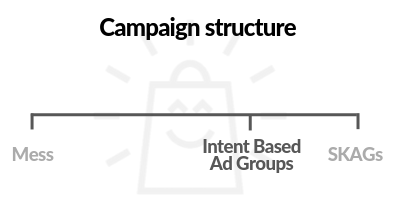
Instead of focusing on keywords, we create looser ad groups that combine keywords with the same intent.
Matching a searcher’s intent means that our ads address what a searcher is trying to accomplish.
Someone searching for “garden hoses price” or “garden hoses cost” is price-conscious. And our ads need to have an answer to that.
That means we can’t focus blindly on the number of clicks in the search terms report, we’ll need to actually understand 😱 what a person is looking for and whether or not that intent is already addressed in our structure.
SKAGS vs IBAGS
Before I show you how to implement this strategy in your campaigns let’s see how intent-based ad groups stack up against single keyword ad groups.
| SKAGS | IBAGS | |
| Ad testing | Hard | Easy |
| Adapted to 2025 keyword match types | No | Yes |
| CTR | High | Medium |
| Difficulty to learn | Easy | Medium |
| Negative keywords | Tons | Moderate |
| Granularity | Extreme | Medium |
| Future proof | No | Yes |
How to Create Intent-Based Ad Groups
With all this theory behind us, it’s time to get cracking.
In what follows, I’m starting from scratch. If you already have campaigns running, the approach below still works fine but you will need to adapt it here and there.
1. Seed Keywords: Foundation
No matter which campaign structure you’re using, you still need to start out with keyword research. (Not going to cover it here in detail, so go check out that article!)
These seed keywords will populate your initial ad groups.
I usually go pretty deep with my keyword research, but then won’t use all of the keywords that I’ve found.
I always try to create ad groups for the categories, brands, and product level, if the search volume on the keywords allows for that.
Here is a quick and dirty check I did for “garden hoses”:
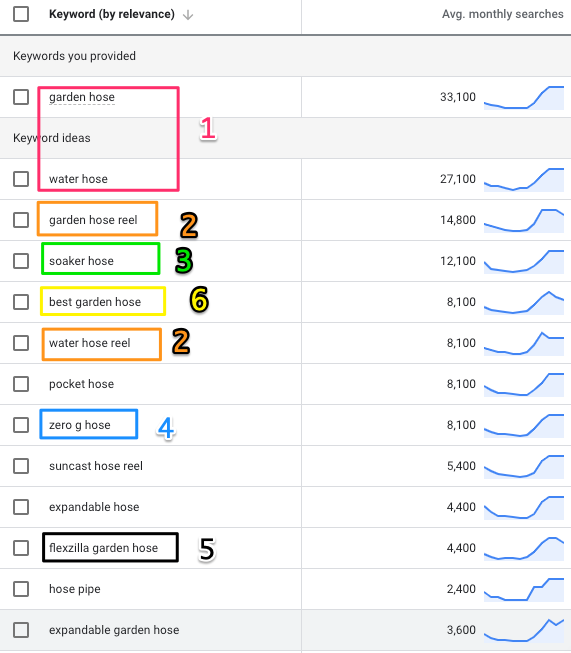
Just from this list, there is already a rough structure emerging. I would group the keywords in the same colored box into the same ad group.
So ad group #2 contains: garden hose reel and water hose reel.
Ad group #5 contains flexzilla garden hose.
Further keyword research would show perhaps more detailed searches for the various flexzilla garden hoses, those would be further split off (ibagged?).
One thing to look out for is not wasting effort by starting out with ad groups that have keywords that only get searched for 10-20 times per month.
If those keywords do get interesting search volumes, they’ll show up in the search report. (I’ll show this below).
I add these keywords with the two match types of these keywords.
So for example:
- Phrase match: “garden hose reel”
- Exact match: [garden hose reel]
I did not include the broad match keyword in the example. That’s because it is the least restrictive keyword match type, which means it will show for a very wide variety of search queries, something we’re looking to avoid with our new structure.
Pro-tip: use the Google Ads Editor to create ad groups and ad keywords. It’s much faster and makes copy/pasting, text replacing and spot checks a lot easier.
2. The IBAGS And Bidding Strategy
Intent-Based Ad Groups aren’t very different from other types of campaigns when it comes to the bidding strategy.
If you’re starting out, go with Manual CPC and set a Max. CPC on the ad group level.
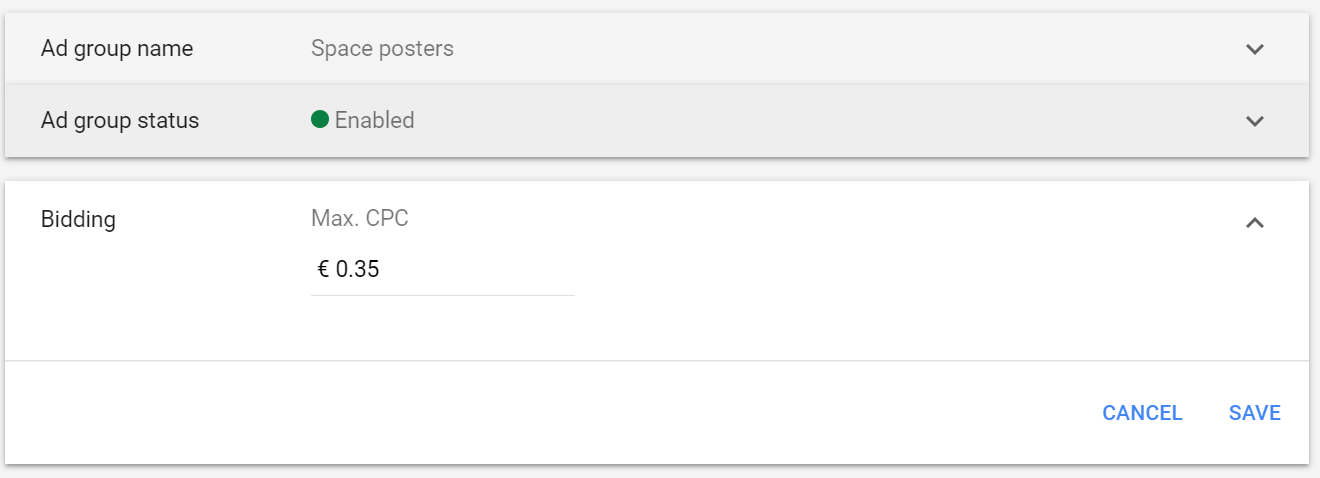
After your campaigns have been running for a while, you’ll get more insights into the performance of keywords and their specific keywords match types in your campaigns.
Then you can start tweaking those bids accordingly.
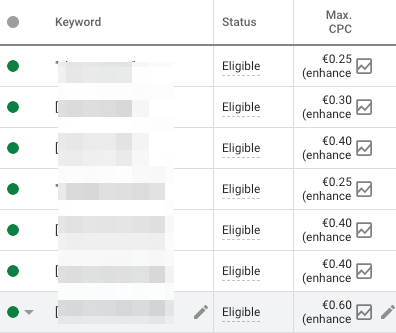
3. Write Ads for your IBAGs
Writing ads with single keyword ad groups was pretty straightforward. You take the keyword and repeat it a few times in your ad.
Right now we’ve got fewer ad groups, but they are all grouped by intent. This means that although the exact wording can be a little different, people searching for these keywords essentially means the same thing.
That means we have to get as specific as we can in the ad.
Here is the process that I follow:
Headline 1
Repeat the main keyword.
This makes your ad more relevant to your searchers, increases your click-through rate, and quality score.
Since the wording of the keywords within the ad group changes slightly: garden hose vs water hose, for example, some people might not realize it means the same thing.
This could have an impact on the CTR. To avoid this you could experiment with Dynamic Keyword Insertion:
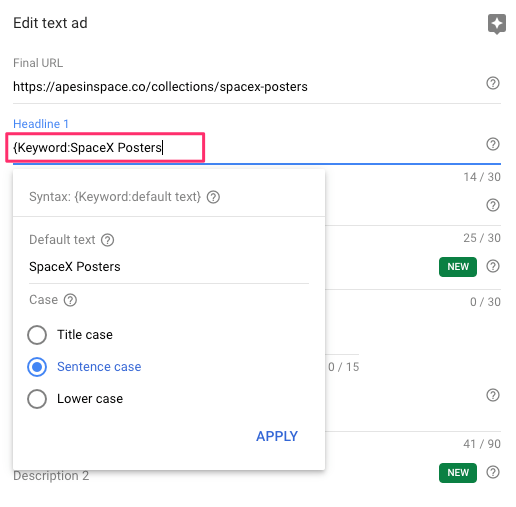
Headline 2/3
Unique Selling Proposition (USP) or differentiator. Can be something like “Free Shipping And Returns”.
Description text
The description text is the part where you can really play into the intent.
If the keywords contain price or cost, talk about your pricing. If they are category searches, mention the size of your catalog. If people are searching for reviews, mention how people rate your product (or your store). If you’re writing product-specific copy, talk about the benefits and the features of the product.
Finish with a clear call to action (CTA) at the end.
Display path
The display path is another place to show potential visitors that you have what they need.
I usually try to reuse the keywords.
In this ad for “spacex posters”, I try to show that I’ve got a whole category dedicated to SpaceX poster:

In another example a retailer shows that he has the product someone is looking for:

As a cherry on top of the cake, be sure to equip your ad groups with ad assets (extensions).
Pro-tip: Create at least two drastically different ads for each ad group, that makes it easier to improve your click-through rate over time. Switch the ad rotation to Optimize.
How to Optimize IBAGs Campaigns
As with all Google Ads campaigns, the real work begins once you’ve launched your campaigns.
Here is how I optimize my campaigns.
Digging Into The Search Terms Report
For most of your initial optimization work, you’ll use the search terms report.
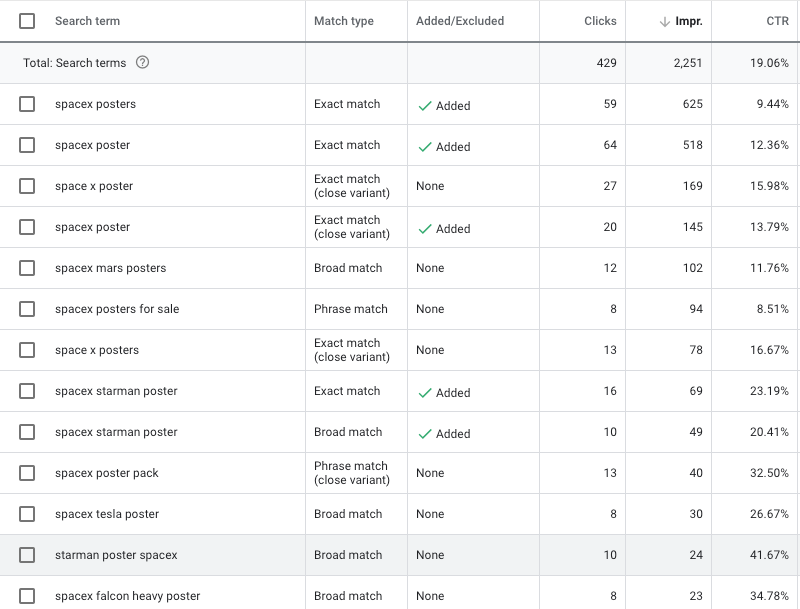
It’s in there that you’ll discover new keywords that you missed or didn’t come up during your research.
If there is some volume ( > 20 clicks in the last 30 days), add it to your existing ad group.
If there is some volume but the intent of the keyword is different, you can split it off into a new ad group.
You can then add that keyword as a negative to the original ad group.
Example
Here is the Search Terms report (of the last 30 days) for an ad group that contains our seed keyword “robot lawn mower”:
- robot Lawn mower – 123 clicks
- robot lawn mower price – 42 clicks
- husqvarna robotic lawn mower – 35 clicks
- honda robot lawn mower – 28 clicks
- robotic lawn mower reviews – 25 clicks
- best robotic lawn mower – 21 clicks
- robot lawn mower cost – 18 clicks
- electric robot lawn mower – 15 clicks
- robot lawn mower comparison – 6 clicks
- husqvarna robotic lawn mower price – 5 clicks
- robot mowers for large lawns – 3 clicks
Based on the following report, I’d make the following decisions:
- New ad group: “cost and price” searches
- New ad group: “husqvarna robot lawn mower” searches
- New ad group: “honda robot lawn mower” searches
- New ad group: “robotic lawn mower reviews”
- Add “best robotic lawn mower” as a phrase match keyword to the original ad group
The other search terms have potential, but that’s not showing yet.
You’ll also find many negative keywords that you might want to exclude from your campaign. You can do this as well from the Search terms Report.
Bidding
While you’re working on refining your campaign structure, you can get serious about your bid strategy.
At first, your changes will be focused on visibility. Raising max CPCs if you’re not getting any traffic, or lowering them when it gets too expensive.
But as the days, weeks and months roll by, the actual sales performance will start driving your decisions.
You might get more granular and start to set different max CPCs on the keyword level.
Once you get a consistent performance from your campaign, it’s worth it to start looking into automated bidding strategies like target ROAS.
IBAGS Ad Testing
Another advantage of the IBAGS approach over SKAGS is that ad testing goes a lot faster.
If you’ve created two ads in each ad group, you should see a clear winner emerge after 100-200 clicks.
Pause the one that’s underperforming and create a new variation of the winning ad.
If the performance of both ads (CTR and conversion rate) is very similar, it’s probably because those ads are too similar.
Consider pausing one of them and rewriting them a bit more drastically.
Future-Proofing Your Search Campaigns With IBAGS
Intent-Based Ad Groups are a solid alternative to Single Keyword Ad Groups. They shift the focus from keywords to intent.
This ensures your CTRs, quality scores, and CPCs are competitive and offers an answer to Google’s evolving keyword match types.
If used right, this approach will increase the performance of your Google Ads campaigns.
Questions? Counter arguments? Can’t wait to hear them in the comments 🙂
